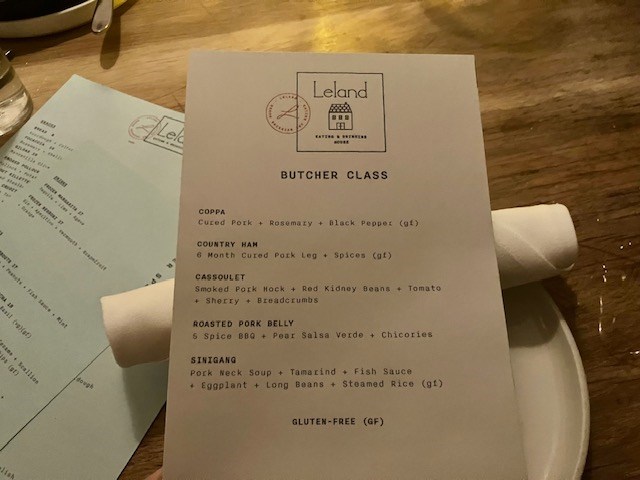Porchetta Focaccia Sandwich. Country Ham. Smoked Pork Belly.
Not only can you enjoy these delectable dishes from an ever-changing menu at Leland Eating and Drinking House, but you can also learn about the butchery process used to prepare them.
Twice a month, the Prospect Heights restaurant known for its focus on local food and wine, opens its kitchen doors for a butchery class and tasting dinner. Depending on the season, Leland offers a pork, duck or tuna butchery demonstration.
On a recent weekday evening, the restaurant gave foodies an inside look on how to butcher a pig. Following the class, guests enjoyed a candlelit pork-based dinner and made new friends.
The evening began with a drink at the bar upstairs before attendees were led to the downstairs kitchen and a cozy, chic dining area that was constructed specifically for behind-the-scenes events.
As an introduction, Randi Lee, the owner of Leland, spoke about the restaurant's philosophy and its focus on in-house butchering.
“When we were building this restaurant, we wanted to make sure we were in touch with every one of our farmers. Our menu changes daily because our cuts are different and the pigs are different," Lee said.
Gary Little, a chef and butcher at Leland, then walked guests through the body of the pig, explaining the dozens of ways different parts of the animal are used in various recipes.
Little emphasized the importance of the pig's red color.
“Animals are red inside. Your meat should be red. The reason pork products from commercially raised pigs aren’t red inside is that they don’t live very active lives,” he said.
He also added: “Happy animals taste better.”
Little then demonstrated how to remove the caul fat, a layer of tissue that separates the spine from the internal organs. There are many uses for this fat layer, which makes for a great seasoning agent, he said.
"In Sicily, they wrap meatballs with it. In Korea, they dry it out, turn it into powder, and use it in a kimchi-style pickling agent,” he explained.
Next, Little cut out the coppa, the muscle the pig uses to move its head and a part of the animal that Leland uses for curing meat. To cure the coppa, Little hangs the meat for 90 days in the walk-in refrigerator, allowing a mold culture to form on the outside.
“By letting that mold culture ferment and work its way through, it creates a very soft, light texture,” he said.
Guests then tasted Leland’s coppa, seasoned with rosemary and black pepper, as part of the dinner menu.
In addition to cutting the loin, shoulder blade and ribs, Little pointed out the importance of the hock, the joint that connects the foot of the pig to its leg. At Leland, the hock is used to make a cassoulet, a french stew-like dish that was also part of the tasting menu.
“We take the hocks, smoke them, and cook them with beans, and add a little bit of breadcrumbs to thicken it up. It' s a very traditional dish. This dates back at least to the Roman Empire” Little noted.
Upcoming events at Leland include Dog-O-Ween on Oct. 28, Eating with the Season: Edible Schoolyard NYC @ Ace Hotel Brooklyn on Oct. 30, and the next Butchery Class on Nov. 6.






